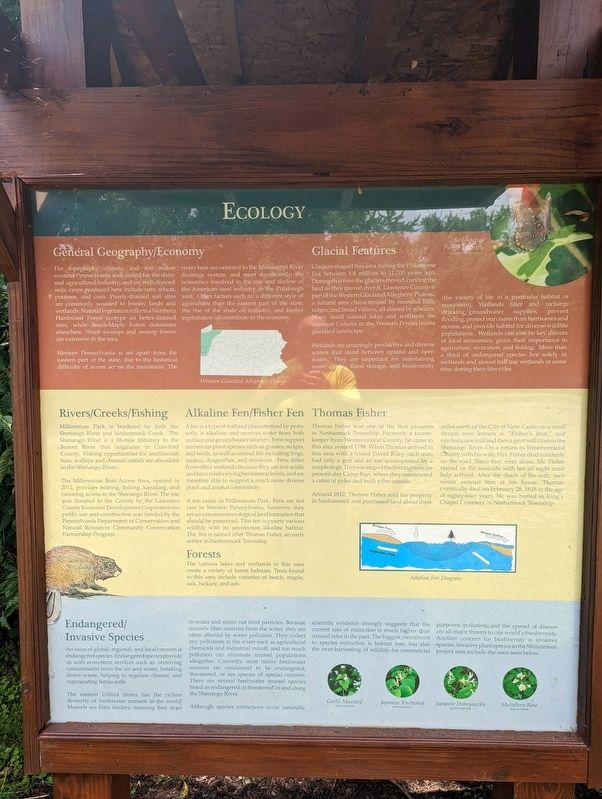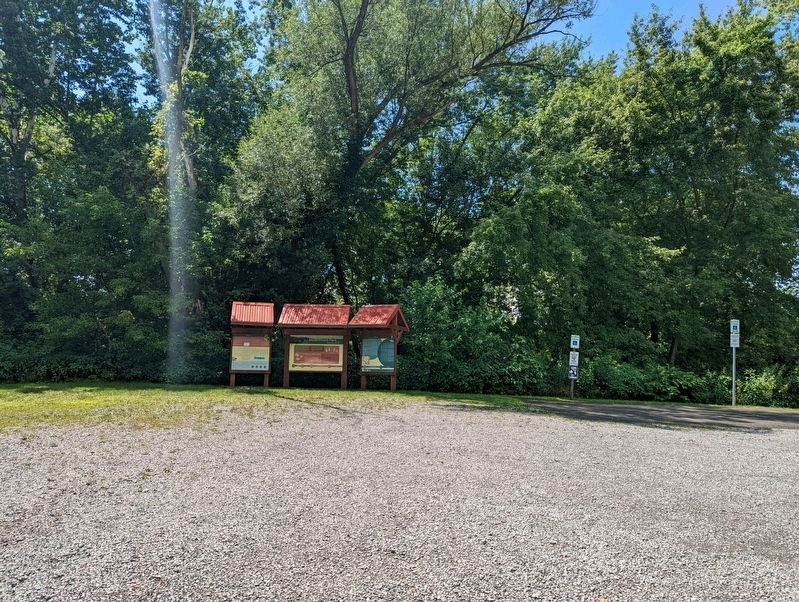Oakwood in Lawrence County, Pennsylvania — The American Northeast (Mid-Atlantic)
Millennium Park
Ecology
The topography, climate, and soil makes western Pennsylvania well-suited for the dairy and agricultural industry, and on well-drained soils, crops produced here include oats, wheat, potatoes, and corn. Poorly-drained soil sites are commonly wooded to brushy lands and wetlands. Natural vegetation reflects a Northern Hardwood Forest ecotype on better-drained sites, while Beech-Maple Forest dominates elsewhere. Shrub swamps and swamp forests are extensive in the area.
Western Pennsylvania is set apart from the eastern part of the state, due the the historical difficulty of access across the mountains. The rivers here are oriented to the Mississippi River drainage system, and most significantly, the economics involved in the rise and decline of the American steel industry in the Pittsburgh area. Other factors such as: a different style of agriculture than the eastern part of the state, the rise of the shale oil industry, and timber exploitation all contribute to the economy.
Glacial Features
Glaciers shaped this area during the Pleistocene Era between 1.8 million and 11,700 year ago. During that time the glaciers moved, carving the land as the moved over it. Lawrence County is part of the Western Glaciated Allegheny Plateau, a natural area characterized by rounded hills, ridges, and broad valleys, all altered by glaciers. Many small natural lakes and wetlands are common features in the Western Pennsylvania glaciated landscape.
Wetlands are amazingly productive and diverse waters that stand between upland and open water. They are important for maintaining water quality, flood storage, and biodiversity (the variety of life in a particular habitat or ecosystem). Wetlands filter and recharge drinking/ groundwater supplies, prevent flooding, protect our coasts from hurricanes an storms, and provide habitat for diverse wildlife populations. Wetlands can also be key drivers of local economies, given their importance to agriculture, recreation, and fishing. More than a third of endangered species live solely in wetland and almost half use wetlands at some time during their lifecycles.
Rivers/Creeks/Fishing
Millennium Park is bordered by both the Shenango River and Neshannock Creek. The Shenango River is a 68-mile tributary to the Beaver River that originates in Crawford County. Fishing opportunities for smallmouth bass, walleye and channel catfish are abundant in the Shenango River.
The Millennium Boat Access Area, opened in 2012, provides boating, fishing, kayaking, and canoeing access to the Shenango River. The site was donated to the County by the Lawrence County Economic Development Corporation for public use and construction was funded by the Pennsylvania Department of Conservation and Natural Resources Community Conservation Partnership Program.
Alkaline Fen/Fisher Fen
A fen is a type of wetland characterized by peaty soils, is alkaline, and receives water from both surface and groundwater sources. Fens support numerous plant species such as grasses, sedges, and reeds, as well as animal life including frogs, snakes, dragonflies, and muskrats. Fens differ from other wetlands because they are less acidic and have relatively higher mineral levels, and are therefore able to support a much more diverse plant and animal community.
A fen exists in Millennium Park. Fens are not rare in Western Pennsylvania, however, they are an uncommon ecological land formation that should be preserved. This fen supports various wildlife with its uncommon alkaline habitat. The fen is named after Thomas Fisher, and early settler in Neshannock Township.
Forests
The various lakes and wetlands in this area create a variety of forest habitats. Trees found in this area include varieties of beech, maple, oak, hickory, and ash.
Thomas Fisher
Thomas Fisher was one of the first pioneers in Neshannock Township. Formerly a tavern-keeper from Westmoreland County, he came to this area around 1798. When Thomas arrived in this area with a friend David Riley, each man had only a gun and an axe accompanied by a couple dogs. They encamped the first night on the present-day Camp Run, where they constructed a cabin of poles and built a fire outside.
Around 1810, Thomas Fisher sold his property in Neshannock and purchased land about three miles north of the City of New Castle on a small stream now known as "Fisher's Run," and erected a saw mill and then a grist mill close to the Shenango River. On a return to Westmoreland County with his wife, Mrs. Fisher died suddenly on the road. Since they ware alone, Mr. Fisher stayed on the roadside with her all night until help arrived. After the death of his wife, two nieces assisted him at his house. Thomas eventually died on February 28, 1848 at the age of eighty-four years. He was buried in King's Chapel Cemetery in Neshannock Township.
Endangered/Invasive Species
An issue of global, regional, and local concern is endangered species. Endangered species provide us with ecosystem services such as: removing contaminants from the air and water, breaking down waste, helping to regulate climate, and regenerating fertile soils.
The eastern United States has the richest diversity of freshwater mussels in the worls. Mussels are filter feeders, meaning they draw in water and strain out food particles. Because mussels filter material from the water, they are often affected by water pollution. They collect any pollutants in the water such as agricultural chemicals and industrial runoff, and too much pollution can eliminate mussel populations altogether. Currently, most native freshwater mussels considered to be endangered, threatened, or are species of special concern. There are several freshwater mussel species listed as endangered or threatened in and along the Shenango River.
Although species extinctions occur naturally, scientific evidence strongly suggests that the current rate of extinction is much higher than natural rates in the past. The biggest contributor to species extinction is habitat loss, but also the over-harvesting of wildlife for commercial purposes, pollution, and the spread of disease are all major threats to our world's biodiversity. Another concern for biodiversity is invasive species. Invasive species in the Millennium project area include the ones seen below.
Topics. This historical marker is listed in this topic list: Environment.
Location. 41° 2.257′ N, 80° 24.178′ W. Marker is in Oakwood, Pennsylvania, in Lawrence County. Marker can be reached from the intersection of Kings Chapel Road and Pulaski Road, on the right when traveling south. Touch for map. Marker is in this post office area: New Castle PA 16101, United States of America. Touch for directions.
Other nearby markers. At least 8 other markers are within 3 miles of this marker, measured as the crow flies. A different marker also named Millennium Park (here, next to this marker); a different marker also named Millennium Park (here, next to this marker); Harbor Creek (approx. ¼ mile away); The First M.E. Church in Lawrence County (approx. 1.1 miles away); Cross-Cut Canal (approx. 2.3 miles away); Ira D. Sankey (approx. 2.4 miles away); Edinburg World War II Memorial (approx. 2½ miles away); Kush-Kush-Kee (approx. 2.6 miles away). Touch for a list and map of all markers in Oakwood.
Credits. This page was last revised on August 2, 2022. It was originally submitted on August 2, 2022, by Mike Wintermantel of Pittsburgh, Pennsylvania. This page has been viewed 132 times since then and 45 times this year. Photos: 1, 2. submitted on August 2, 2022, by Mike Wintermantel of Pittsburgh, Pennsylvania.

